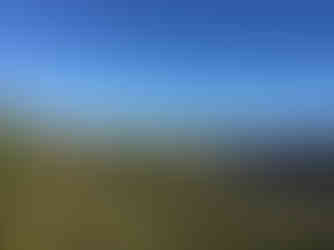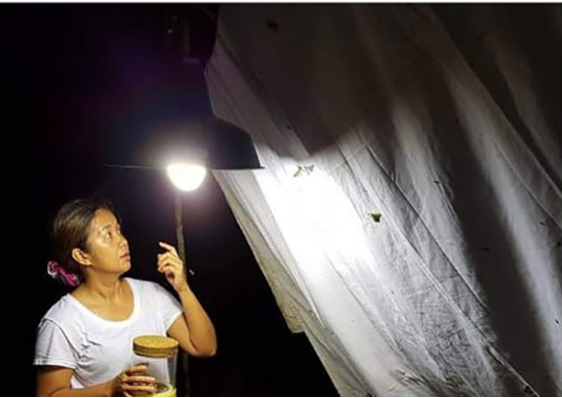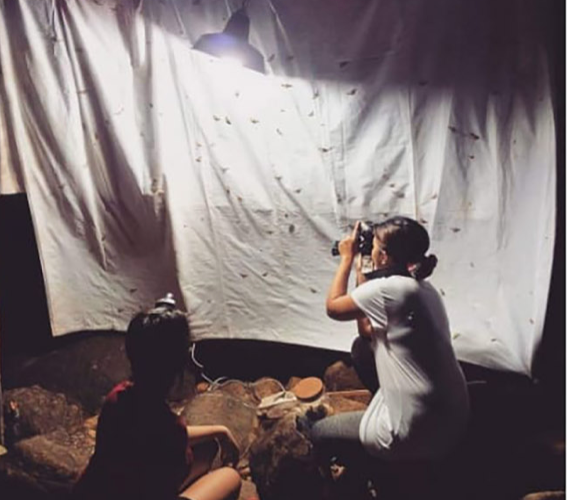STEM doesn’t just happen in the confines of your room or inside a lab! We peek through the Field Notes of these STEM women on the field —and find out what happens right where the action is!
Through these past few months, we’ve gathered notable Pinays, (friendly) girl gangs, and SHS ates that can help us pave the way for our STEM journey. This time around, we’re sharing the spotlight with the women working right where the action is.
These longtime scientists, researchers, and everything-ists have been living the dream—and now, they’re sharing vital ‘field notes’ to us. Who knows? They could well be your mentors someday.
Gracile Roxas
MPhil Textile Conservation postgraduate student, University of Glasgow

Monuments of Juan Luna (artist) and Antonio Luna (chemist).
Gracile has been a longtime researcher at the National Historical Commission of the Philippines (NCHP), involved in the conservation of tangible heritage in the country. Through her multidisciplinary work, she was able to recognize material and come up with conservation procedures on important artifacts like documents, books, clothes, artworks and furniture found in the 27 museums managed by NHCP. She is now a postgraduate student taking up MPhil Textile Conservation at the University of Glasgow.
Since then, cultural heritage conservation has been her calling. Besides her love for Science and Math, one of the reasons she pursued STEM was because of Philippine history! She strongly advocates for more STEM workers in the field to be able to help manage the country’s resources, address recurring problems, and eventually become truly self-sustaining.

Church volunteers turned conservation assistants during one of NHCP’s projects in response to the October 2013 earthquake. Bantayan Parish Museum, Cebu, November 19, 2015
Gracile’s Field Notes on becoming a multidisciplinary scientist
‘Conservation of tangible cultural heritage is multidisciplinary in nature—it cannot be classified as a purely artistic endeavor nor purely scientific because it considers the integrity of the material components a heritage object as well as its historic, artistic and cultural value. I get to work with people coming from different educational backgrounds and experiences, not only within NHCP but also in the communities we are serving.’

Doing paper chromatography of inks with participants in a public program by NHCP. Museo ni Jose Rizal Fort Santiago, Manila December 29, 2017.
Gracile’s Field Notes on her early years
‘I realized that I should go beyond that if I really want to become a good conservation science researcher. For example, if you want to study a painting, it helps if you know how to paint and are familiar with materials used by painters. If you want to document and assess the condition of a vintage terno, you would less likely miss the most important details if you are familiar with garment construction. Until now, I have been taking every opportunity to improve my artistic skills and learn new crafting techniques that might help me in research and conservation work.’

Chemical treatment of stains on a watercolor painting. National Historical Commission of the Philippines, March 21, 2014.
Aiko del Rosario
Marine Scientist, UP MSI Physical Oceanography Laboratory

Aiko is a champ in the field of physical oceanography, as she analyzes the ever-changing physical attributes of the ocean (‘swirls and blobs’ she describes) using satellite data, oceanographic equipment, and high-frequency radars.
She frequently visits the Cagayan coasts for field work, maintaining two radars in monitoring the ocean currents of the Luzon Strait located between Taiwan and the Philippine islands.
Aiko’s Field Notes on being confident on the job
‘I did my first fieldwork [in] February 2018. [We] had to scour the coasts of Cagayan to find a good spot for our ocean monitoring site. Rain or shine, we walked along the coasts of different barangays. I used to fear talking to people I do not know.’
‘These days, I now have a go-bag with a week’s worth of fieldwork clothes in case we need to go to the field to troubleshoot our sites. I am also already used to the locals now and I love every chance I get to talk to them about the science behind the work we do. I also now have a mental map of the place, most of it are places where we get to taste local delicacies!’

Aiko’s Field Notes on the best part of being on the field
‘Doing fieldwork means you have to think on your toes and be present most of the time. We had to make decisions and think of solutions on the spot. One time, we had to lay 500 meters of heavy electrical cable under muddy soil. We did not have a vehicle to pull all of that, so we made a “Pajero”. Basically, we used a carabao with a cart at the back to lay the cables. We also have to be weatherproof. Rain or shine. Day or night.’

Sarah Oliva
Geophysicist/Seismologist

Taken last in Edmonton, Canada last September 2020 when Sarah started her postdoc remotely at University of British Columbia. She also wore this barong-style dress when she defended her doctoral dissertation back in June 2020.
Sarah is a Geophysicist who achieved her PhD at Tulane University in Louisiana. She pursued the field because it was a ‘marriage’ of her two favorite fields: Physics and the Earth.
Before she heads on site, Sarah first does most of her work in front of the computer, detecting and extracting earthquake waves using waveform analysis. When she is needed on the field, she’s in charge of installing and maintaining seismometers so they can accurately record incoming earthquakes. She’s since done fieldwork in Tanzania, Kenya, Ecuador, and Galápagos.
Sarah’s Field Notes on doing field work in a different country
‘I was a first year PhD student and new to the US. It all happened so fast and I had to learn most things on the spot in the field. I remember I did not even have the proper gear and they had to drive me over to Walmart to buy some gloves and an extra pair of non-jeans pants. We stayed in a small town and every morning we had to drive a few hours to the middle-of-nowhere where there was nothing but farmland for miles and miles.’
‘Within those few days, I met a lot of interesting people, including many chatty folks. Overall, those few days of fieldwork made quite an impact to me, in terms of learning actual hands-on fieldwork but also in getting to know a bit more of the country I was in. If it hadn’t been for that experience, succeeding fieldwork travels might have turned out different.’
Sarah’s Field Notes on her biggest inspiration
‘The largest contributing factors to my pursuit of STEM are my supportive parents and teachers throughout the years. Thanks to them, my environment growing up was conducive to curiosity-driven pursuits and science. I had volumes of illustrated science books and encyclopedias at home. For some time, my dad grilled me regularly with tedious, repetitive, math exercises until I could quickly do calculations in my head (I did not enjoy those, but I benefited greatly from them).’
‘This might sound trivial to some, but in the simplest sense, one important contributing factor to my pursuit of STEM is that nobody told me I couldn’t.’

She adds, ‘Surround yourself with supportive like-minded people. Reach out to local STEM people that inspire you, they might become your mentor and guide you through your own career. Approach us. We were once novices like you and most of us would jump at an opportunity to help you make an informed decision on whether or not to pursue our field as a career. Ask. Ask questions. Ask for help. Communicate.’
Dr. Aimee Dupo
Entomologist & professor at the Institute of Biological Science, UPLB
Dr. Aimee is an entomologist who graduated in Agriculture, majoring in Entomology, from UPLB back in 1999. She now serves as professor at UPLB, as her work in the classification of insect life earned her the 2015 NAST Outstanding Young Scientist award and the 2017 Bato Balani Many Faces of a Teacher Award.
She started her fieldwork when she served as the University Extension Associate of the UPLB Museum of Natural History, curating samples of spiders and moths for the gallery. With fieldwork being her position’s norm, she shares that there were quite a few days when I was not out on the field.’
Dr. Aimee’s Field Notes on the freedom of field work
‘Going on field always feels like an adventure. You would never know what you are going to discover next. All of your senses are exposed to so many stimuli but at the same time you are also worried about what would happen in case of an accident. Fieldwork tends to bring you to places where hospitals are far away.’

Entering the caves in Pangasinan. Photo courtesy of Balincaguin Conservancy.
Dr. Aimee’s Field Notes on the power of mentors
‘I had a lot of mentors and colleagues who helped create and enable [the] environment for me to pursue STEM. They pushed and encouraged me to do more because they were that supportive. There were no words like, “You can’t do that,” only, “Try and see what you can learn from it.” More importantly, there was no mention of the concept, “You’re just a girl.”’

Documenting arthropods visiting Rafflesia in Mt. Makiling, Los Banos Laguna
Noreen “Kubi” Follosco
Coastal Systems researcher, Marine Environment & Resources Foundation, UP Diliman

Orientation on climate change adaptation in Coron, Palawan last July 2019. Photo courtesy of MERF USAID Fish Right Project.
Noreen is a researcher working on the resilience of local coastal adaptation, marine protected areas, and ecosystem services in the Philippines. She mostly works as a trainer, developing resources and building capacity on climate change adaptation for coastal communities.
She studied Biology at the University of the Philippines Baguio for her undergraduate degree, and Environmental Science at the Institute of Environmental Science and Meteorology at the University of the Philippines Diliman for her master’s.
Noreen’s Field Notes on changing roles on site
‘When I began doing fieldwork, it was mostly for biophysical surveys. For example, I’ve joined surveys for both upland, as well as mangrove, forests. The surveys in mangroves were to better understand how they stabilize the coast, and protect coastal communities.’
‘Over the years, my work transformed into communicating, and finding ways to apply science meaningfully in conservation & management. So, I found myself interacting more with local governments and communities, rather than being in the water (or the mud, as is often the case in mangroves).’
‘I always look forward to what I can learn in the field. Spending time in coastal and fisher communities is an instructive and humbling experience—I’m reminded that I actually know so little. We have much to learn from indigenous and local knowledge.’

Interviews about resilience with residents of Calawit Island, Busuanga last September 2019. Photo courtesy of Mags Quibilan.
Noreen’s Field Notes on the goal of the job
‘In my work, one of the challenges is effectively translating technical information for practical use. A key aim of our work is to transfer knowledge generated through scientific research to settings where people are directly interacting with their environment. My ultimate goal is to build capacity so effectively that the coastal communities (we’ve worked with) can self-sustain, and are empowered to continue sharing the knowledge forward themselves.’

Irene Crisologo
Climatologist/Geologist

Irene is a jill of all trades in the STEM world, as she’s hailed from the different fields of Physics, Geology, then Geoecology. While attending a workshop on weather radars, she said to herself: “This is it! This is what I want to do.”
Since then, Irene has been in the US focusing on studying the rainfall-measuring instruments called weather radars. She researches the data that weather radars collect, and develops possibilities to reduce errors in measurement and interpretation. Her postdoctoral project involves looking at strong winter storms in the West Coast.
Irene’s Field Notes on the rush of being on site
‘Doing a masters in Geology introduced me to doing fieldworks. It was incredibly exciting, going to different places and being able to physically touch the things I’m studying in their natural location. As a young student then, the added bonus of traveling to obscure locations that I would not have otherwise reached gave a big sense of adventure.’
‘On top of that, I had good company with my labmates. Doing fieldwork with other people forms bonds with them, as you see each other in various modes of being human—from the work mode in planning and coordinating, to seeing each other exhausted from walking all day and carrying rocks or water samples, to knowing what they are like when you’re all hungry and stinky after a long day of work.’

Irene’s Field Notes on fieldwork’s little learnings
‘No two fieldworks are the same. Even if you’re going to the same location twice, to collect the same data (whether it’s rocks, soil, water, temperature), the environment is always changing because nature is unpredictable. But all these challenges also teach you how to adapt to different situations. It teaches you how to be flexible, and to think fast and make quick decisions, and knowing the priority of the group (for example, safety).’

Dr. Deborah N. Tangunan
Paleoclimatologist/biogeochemist/marine micropaleontologist

Dr. Tangunan was one of the science slammers during the Science Slam (Seas and Oceans) Regional Competition in Northern Germany back in 2017. Photo courtesy of Florian Koch.
Dr. Deborah is an experienced Geologist with expertise in micropaleontology, biogeochemistry, and paleoclimatology. Her work literally goes way back, as she studies the tiniest of Earth’s fossils to get history’s answers on today’s climate crisis.
Under the University of the Philippine’s National Institute of Geological Sciences, most of her fieldwork happened on land. Later on, she focused on studying marine sediment cores in places like Bohol, Sulu, the Sibuyan sea, and even the Pacific Ocean. With a geologist’s laboratory essentially being “the Earth”, Deborah has literally done her work across the border.
Deborah’s Field Notes on the country’s STEM challenges
‘Of course, there’s always the problem of limited funding allotted for research, or science in general—in the Philippines. When I went abroad for my Ph.D. and eventually for Post Docs, there were a lot of funding grants and opportunities but competition is too high. It’s difficult when you are just beginning to establish a “home” in one place and then realize that you have to move out again. Well, with a lot of opportunities for scientists here, I was never afraid to try anything.’
Deborah’s Field Notes on the thrill of exploring
‘There are a number of exciting parts to being a geologist, especially with my field of specialization: I get to travel to places I never imagine I could ever go to. I have travelled to many Philippine provinces, a number of countries, and oceans. A memorable one was the equator crossing when we were sailing in the Pacific Ocean. Research expeditions at sea for several weeks or months have allowed me to meet and work with fantastic people and scientists onboard, some of them became my mentors and collaborators in my future research endeavors.’

She adds, ‘One example is how I got my Ph.D. position in Germany. I was half-way down my MS degree program when I met this scientist whose papers I’ve been reading for a while. Several months past and I was set that I wanted him to be my Ph.D. supervisor so I wrote an email asking him if by any chance, there will be an open Ph.D. position in his university. He gave me advice and reminded me that even if he already “wanted” me for the position, I still need to convince the other members of the panel that I deserve the position. I got the position.
You cannot work alone. Collaboration and networking are key components of doing science.’
It’s not everyday that we can take a peek into the field notes of our idols, but if their notes could talk, they’d likely say that though every field of work will be difficult, following your passion requires love and passion that just comes easy.
Good luck, future STEM Women on Site!






























Comments